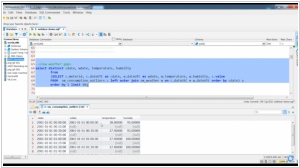Teradata vs Vertica
March 19, 2025 | Author: Michael Stromann
11★
Teradata Aster features Teradata Aster SQL-GR analytic engine which is a native graph processing engine for Graph Analysis across big data sets. Using this next generation analytic engine, organizations can easily solve complex business problems such as social network/influencer analysis, fraud detection, supply chain management, network analysis and threat detection, and money laundering.
7★
Vertica offers organizations new and faster ways to store, explore and serve more data. Vertica lets organizations store data in a cost-effectively, explore it quickly and leverage well-known SQL-based tools to get customer insights. By offering blazingly-fast speed, accuracy and security, it offers operational advantages to the entire organization.
See also:
Top 10 Big Data platforms
Top 10 Big Data platforms
Teradata and Vertica are both very clever databases designed to handle absurdly large amounts of data, mostly so that large corporations can make even larger amounts of money. They both speak SQL fluently, know how to spread work across many machines without breaking a sweat and can be found lurking in the cloud when they’re not busy running on-premise. In the grand hierarchy of databases, they are the sort that like to keep things neatly columnar, because row-based storage is just so terribly inefficient when you're dealing with petabytes of customer shopping habits and the meaning of life.
Teradata, being the older and more distinguished of the two, has been around since 1979, which in database years is somewhere between "ancient relic" and "respected elder statesman." It was born in the USA and grew up in a world where big enterprises—banks, retailers and telecoms—needed something rock-solid to crunch numbers for them. It prides itself on handling mixed workloads, never panicking when asked to do both transactions and analytics and ensuring that business executives can always get their quarterly reports in time to take credit for them.
Vertica, by contrast, is the younger, faster, more excitable sibling, arriving in 2005 and quickly getting snapped up by HP like a particularly promising startup at a Silicon Valley buffet. Also American, but with a distinct sense of urgency, it was built for analytics at breakneck speed, compressing data into oblivion and indexing everything in sight. It thrives in the chaotic world of real-time analytics, IoT and machine learning, where people expect answers now, not in a few minutes after a polite cup of tea. If Teradata is the wise old professor of databases, Vertica is the caffeine-fueled data scientist hacking together an AI model at 3 AM.
See also: Top 10 Big Data platforms
Teradata, being the older and more distinguished of the two, has been around since 1979, which in database years is somewhere between "ancient relic" and "respected elder statesman." It was born in the USA and grew up in a world where big enterprises—banks, retailers and telecoms—needed something rock-solid to crunch numbers for them. It prides itself on handling mixed workloads, never panicking when asked to do both transactions and analytics and ensuring that business executives can always get their quarterly reports in time to take credit for them.
Vertica, by contrast, is the younger, faster, more excitable sibling, arriving in 2005 and quickly getting snapped up by HP like a particularly promising startup at a Silicon Valley buffet. Also American, but with a distinct sense of urgency, it was built for analytics at breakneck speed, compressing data into oblivion and indexing everything in sight. It thrives in the chaotic world of real-time analytics, IoT and machine learning, where people expect answers now, not in a few minutes after a polite cup of tea. If Teradata is the wise old professor of databases, Vertica is the caffeine-fueled data scientist hacking together an AI model at 3 AM.
See also: Top 10 Big Data platforms





